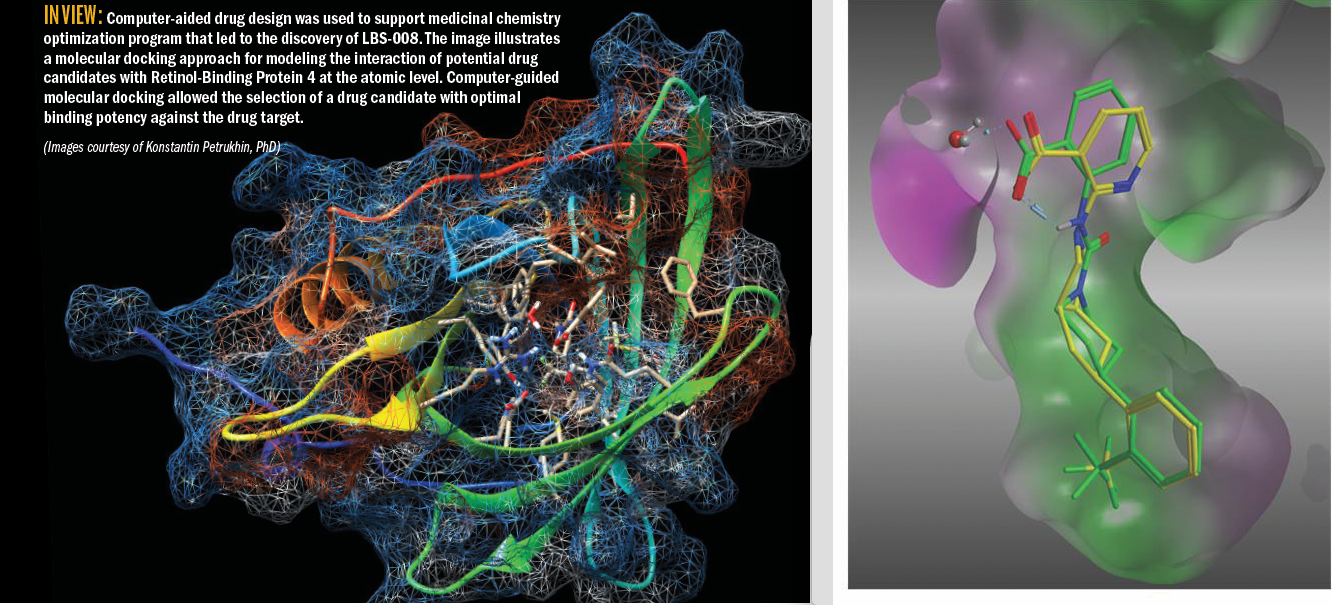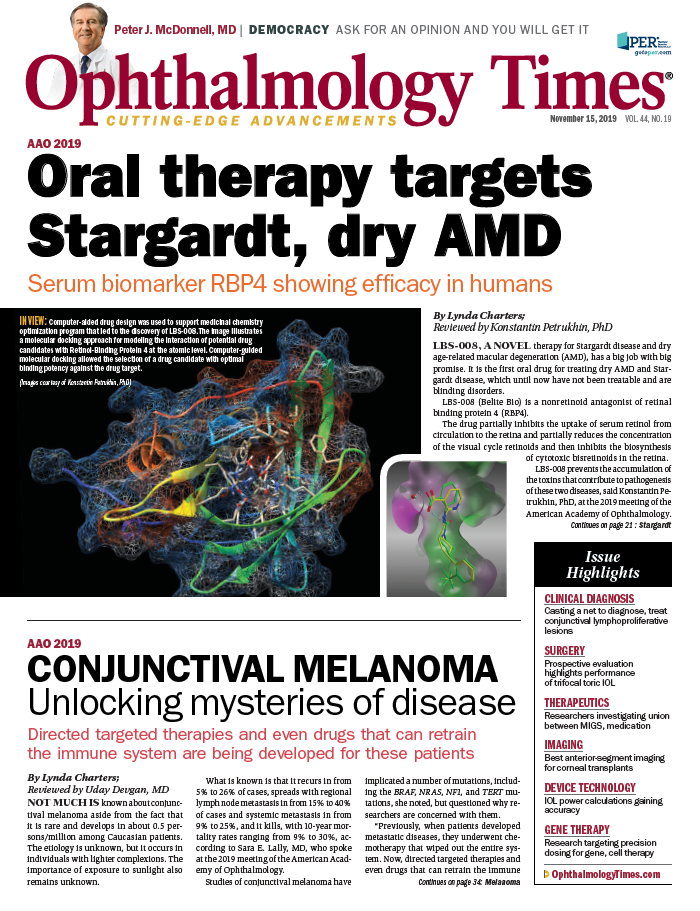News
Article
Digital Edition
Oral therapy targets Stargardt, dry AMD
Author(s):

RBS-008 is a novel oral therapy for Stargardt disease and age-related macular degeneration that was shown to effectively reduce the serum biomarker RBP4.
This article was reviewed by Konstantin Petrukhin, PhD
LBS-008, a novel therapy for Stargardt disease and dry age-related macular degeneration (AMD), has a big job with big promise. The agent is among the first potential oral drugs in development for treating both dry AMD and Stargardt diseases, which, until now, have been untreatable/blinding disorders.
LBS-008 (Belite Bio) is a nonretinoid antagonist of retinol binding protein 4 (RBP4).
The drug partially inhibits the uptake of serum retinol from circulation to the retina and partially reduces the concentration of the visual cycle retinoids and then inhibits the biosynthesis of cytotoxic bisretinoids in the retina.
LBS-008 prevents the accumulation of the toxins that contribute to pathogenesis of these two diseases, said Konstantin Petrukhin, PhD, at the 2019 meeting of the American Academy of Ophthalmology.
LBS-008 engages the retinol binding complex in the circulation, and is therefore an oral drug that does not need to be injected intravitreally.
“The drug also induces very rapid clearance of its target, making reduction of RBP4 a very convenient serum biomarker of the treatment’s efficacy in humans,” said Dr. Petrukhin, professor of ophthalmic science, Department of Ophthalmology, Columbia University, New York.
The preclinical studies showed that LBS-008 very effectively inhibited bisretinoid synthesis and preserved the photoreceptor cells in two genetic models of Stargardt disease.
Following the establishment of the drug’s safety, the investigators went to study the safety, tolerability, pharmacokinetics, and pharmacodynamics in healthy human subjects in a phase 1 randomized, double-blind, placebo-controlled, single and multiple-ascending dose study.
In the single ascending-dose study, which has been completed, Dr. Petrukhin and colleagues evaluated 25-, 50-, 100-, 200-, and 400-mg doses in eight subjects per cohort; six subjects of each cohort were treated with LBS-008 and two received placebo.
“The drug showed a slow elimination rate and there was a modest dose-dependent increase in the exposure to the drug, i.e., doses greater than 50 mg did not result in substantially higher exposure,” he said.
Another important finding was the “remarkable” pharmacodynamic effect of the drug on the biomarker. One dose of LBS-008 produced a sustained reduction of serum RBP4 for several days, which, he pointed out, is consistent with a slow elimination rate.
The multiple-ascending dose study looked at 5-, 10, 12-, and 25-mg doses.
Eight subjects per cohort were evaluated; six were treated with the drug and two with placebo.
“The effect on the biomarker was also very good in this study,” Dr. Petrukhin said. “We were able to induce a sustained reduction in plasma RBP4 below the level that may be associated with clinical efficacy, and at the end of dosing the RBP4 reduction was fully reversible.”
In the single ascending-dose study, one mechanism-based adverse event, mild xanthopsia, occurred in the 100-mg cohort and resolved four days after dosing.
One systemic adverse event occurred, namely, headache, that was considered to be related to the treatment. One ocular adverse effect occurred, mild pinguecula, in the 50-mg cohort that was unrelated to treatment.
In the multiple ascending-dose study, no treatment-related systemic adverse effects occurred, and the most common ocular adverse event was impaired dark adaptation test, but it was not correlated with subjective complaints. All cases returned to normal at the last study visit.
“The combination of adverse events in the multiple ascending-dose study indicates the systemic target engagement that we showed with analysis of the serum biomarker was correlated nicely with the pharmacodynamic effect in the retina,” Dr. Petrukhin said.
Dr. Petrukhin added that the phase I study was a success.
“The drug was very well tolerated systemically and the ocular adverse events were mild, transient, and reversible,” he concluded. “We were able to demonstrate the desired effect on the serum biomarker, and the reduction in RBP4 was below the level that may be considered associated with clinical efficacy in AMD studies. The results indicated that the 10-mg once daily oral dose is the one that may be advanced in future clinical trials in Stargardt disease.”
Konstantin Petrukhin, PhDE: Kep4@cumc.columbia.edu
Dr. Petrukhin invented this technology and is a consultant and advisor to Belite Bio, a U.S. biotechnology company.
Newsletter
Don’t miss out—get Ophthalmology Times updates on the latest clinical advancements and expert interviews, straight to your inbox.






